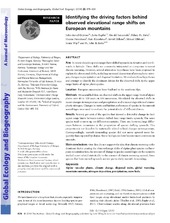| dc.contributor.author | Grytnes, John-Arvid | eng |
| dc.contributor.author | Kapfer, Jutta | eng |
| dc.contributor.author | Jurasinski, Gerald | eng |
| dc.contributor.author | Birks, Hilary H. | eng |
| dc.contributor.author | Henriksen, Hanne | eng |
| dc.contributor.author | Klanderud, Kari | eng |
| dc.contributor.author | Odland, Arvid | eng |
| dc.contributor.author | Ohlson, Mikael | eng |
| dc.contributor.author | Wipf, Sonja | eng |
| dc.contributor.author | Birks, Harry John Betteley | eng |
| dc.date.accessioned | 2014-12-18T11:52:58Z | |
| dc.date.available | 2014-12-18T11:52:58Z | |
| dc.date.issued | 2014-04-13 | eng |
| dc.identifier.issn | 1466-822X | en_US |
| dc.identifier.uri | http://hdl.handle.net/1956/8977 | |
| dc.description.abstract | Aim In recent decades species ranges have shifted upwards in elevation and northwards in latitude. These shifts are commonly interpreted as a response to recent climate warming. However, several alternative hypotheses have been proposed to explain the elevational shifts, including increased deposition of atmospheric nitrogen, changes in precipitation and dispersal limitation. We evaluate these hypotheses and attempt to identify the dominant drivers for the observed shifts in the upper range limits of alpine plant species. Location European mountains from Svalbard to the southern Alps. Methods We assembled data on observed shifts in the upper range limit of alpine plants over 40 to 100 years on 114 mountains. We related the observed shifts to recent changes in temperature and precipitation and to recent deposition of atmospheric nitrogen. Changes in traits and habitat preferences of species in the summit assemblages were used to evaluate the potential role of different drivers. Results Seventy per cent of the species that showed a detectable change in their upper range limits between surveys shifted their range limits upwards. The same species tend to move up on different mountains. There are, however, large differences between mountains in the proportion of species shifting upwards. This proportion is not found to be statistically related to local changes in temperature. Correspondingly, warmth-demanding species did not move upward more frequently than expected by chance. Snow-bed species have become more common on summits. Main conclusions Our data do not support the idea that climate warming is the dominant factor causing the observed range shifts of alpine plant species on European mountains: first, the amount of change in species assemblages on the summits studied is not related statistically to the amount of climate warming; second, those species that have moved upwards are not particularly warmth demanding. | en_US |
| dc.language.iso | eng | eng |
| dc.publisher | Wiley | en_US |
| dc.rights | Attribution-NonCommercial CC BY-NC | eng |
| dc.rights.uri | http://creativecommons.org/licenses/by-nc/3.0/ | eng |
| dc.subject | Alpine vascular plants | eng |
| dc.subject | Climate change | eng |
| dc.subject | dispersal traits | eng |
| dc.subject | Global warming | eng |
| dc.subject | mountain summits | eng |
| dc.subject | nitrogen deposition | eng |
| dc.subject | Precipitation | eng |
| dc.subject | snow beds | eng |
| dc.title | Identifying the driving factors behind observed elevational range shifts on European mountains | en_US |
| dc.type | Peer reviewed | |
| dc.type | Journal article | |
| dc.description.version | publishedVersion | en_US |
| dc.rights.holder | Copyright 2014 The Authors | en_US |
| dc.identifier.doi | https://doi.org/10.1111/geb.12170 | |
| dc.identifier.cristin | 1129198 | |
| dc.source.journal | Global Ecology and Biogeography | |
| dc.source.40 | 23 | |
| dc.source.14 | 8 | |
| dc.source.pagenumber | 876-884 | |

